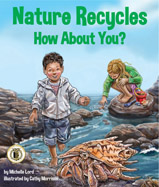Alignment to Standards for DC

| Grade | Number | Standard |
|---|---|---|
| 1 | SC.1.4. | Different types of plants and animals inhabit the Earth. |
| 2 | G 2.1.1. | Understand how maps and globes depict geographical information in different ways. (G) |
| 2 | SC.2.4. | The Earthês resources can be conserved. |
| 2 | SC.2.4.1. | Recognize and explain how certain materials can be used again. |
| 2 | SC.2.4.2. | Explain how discarded products contribute to the problem of waste disposal and how recycling and reuse can help solve this problem. |
| 2 | SC.2.6. | Plants and animals have structures that serve different functions in growth, survival, and reproduction. |
| 2 | SC.2.6.1. | visible, external features of plants and animals and describe how these features help them live in different environments. |
| 2 | SC.2.7.1. | Observe and describe how animals may use plants, or even other animals, for shelter and nesting. |
| 2 | SC.2.7.4. | materials in nature, such as grass, twigs, sticks, and leaves, can be recycled and used again, sometimes in different forms, as birds do in making their nests. |
| 2 | SC.2.8. | Many different types of plants and animals inhabit the Earth. |
| 2 | SC.2.8.1. | living things are found almost everywhere in the world in habitats such as the oceans, rivers, rain forests, mountain ranges, arctic tundra, farms, cities, and other environments. Recognize that some habitats are extreme, such a |
| 2 | SC.2.8.2. | the numbers and types of living things can vary greatly from place to place. |
| 3 | SC.3.5.1. | living things can be sorted into groups in many ways using various properties, such as how they look, where they live, and how they act, in order to decide which things belong to which group. |
| 5 | SC.5.8. | Many characteristics of an organism are inherited from the parents, but others result from the influence of the environment. |
| 5 | SC.5.8.2. | List some characteristics of plants and animals that are fully inherited (e.g., form of flower, shape of leaves) and others that are affected by the climate or environmental conditions (e.g., browning of leaves from too much sun, language spoken). |
| 5 | SC.5.9. | Adaptations in physical structure or behavior may improve an organismês chance for survival. |
| 5 | SC.5.9.7. | Recognize that some behaviors are instinctive (turtles burying their eggs) and others learned (wolfês hunting skills). |
| K | G K.1. 2. | Demonstrate familiarity with what a map is and what a globe is. (G) |
| K-2 | G K-2.1. | Students use map and globe skills to determine the locations of places. |